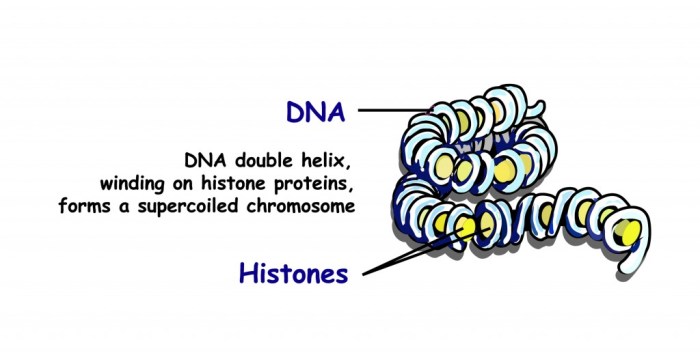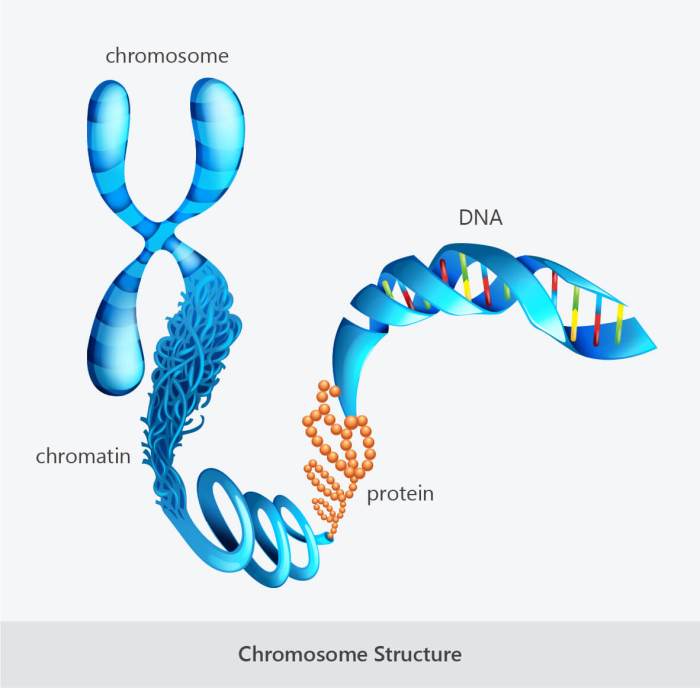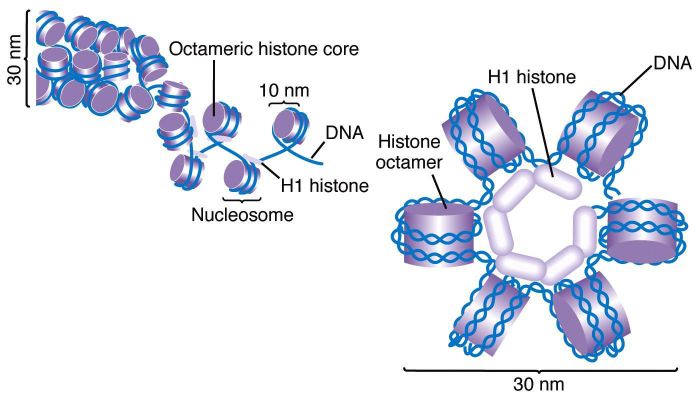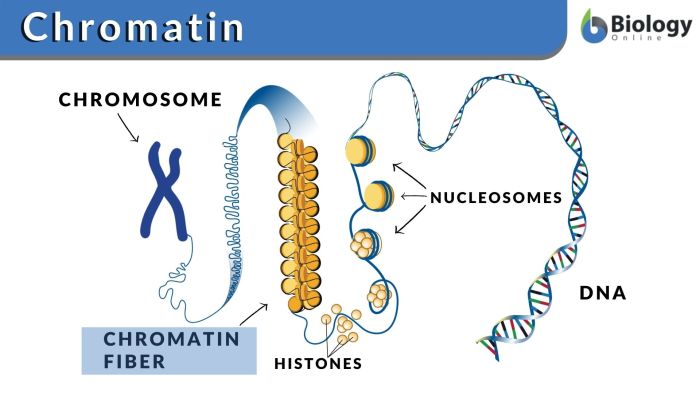Which of the following statements about chromatin is true? This question delves into the intricate world of chromatin, a fundamental component of our cells that plays a pivotal role in gene regulation and cellular processes. Join us as we unravel the mysteries of chromatin, exploring its structure, function, and the profound implications it holds for our understanding of health and disease.
Chromatin, a complex and dynamic substance, is composed of DNA and proteins. It exists in two primary forms: euchromatin, which is loosely packed and transcriptionally active, and heterochromatin, which is tightly packed and transcriptionally inactive. The intricate structure of chromatin, with its nucleosomes and higher-order folding, provides a sophisticated level of gene regulation, allowing cells to control which genes are expressed and when.
Chromatin Structure
Chromatin is a complex structure composed of DNA, proteins, and RNA molecules. It is found within the nucleus of eukaryotic cells and plays a vital role in gene regulation and cellular processes.
Composition of Chromatin
- DNA:Chromatin contains the genetic material of the cell, consisting of two strands of DNA wrapped around each other to form a double helix.
- Histones:These are small, positively charged proteins that bind to DNA and form the basic structural unit of chromatin, called a nucleosome.
- Non-histone proteins:A wide variety of other proteins are associated with chromatin, including enzymes involved in gene regulation, DNA replication, and repair.
- RNA molecules:Small RNA molecules, such as microRNAs, can also bind to chromatin and regulate gene expression.
Types of Chromatin
Based on its structure and accessibility, chromatin is divided into two primary types:
- Euchromatin:This is loosely packed chromatin that is transcriptionally active, meaning it is accessible to transcription factors and RNA polymerase for gene expression.
- Heterochromatin:This is tightly packed chromatin that is transcriptionally inactive and serves to protect and maintain the integrity of the genome.
Chromatin Structure
Chromatin is organized into a hierarchical structure, starting with the nucleosome, which consists of DNA wrapped around eight histone proteins. Nucleosomes are then arranged into chromatin fibers, which are further coiled into loops and finally packaged into chromosomes.
The structure of chromatin is dynamic and can change in response to cellular processes, such as gene regulation and DNA replication.
Chromatin Function

Role in Gene Regulation
Chromatin plays a crucial role in gene regulation by controlling the accessibility of DNA to transcription factors and RNA polymerase. Euchromatin is generally more accessible, allowing for gene expression, while heterochromatin is less accessible, preventing gene expression.
Chromatin Modifications
The structure of chromatin can be modified by various mechanisms, including histone modifications, DNA methylation, and non-coding RNA molecules. These modifications can affect gene expression by altering the accessibility of DNA.
Importance in Cellular Processes
Chromatin is involved in various cellular processes, including:
- DNA replication:Chromatin structure must be unwound and reassembled during DNA replication.
- DNA repair:Chromatin modifications can facilitate DNA repair mechanisms.
- Cellular differentiation:Changes in chromatin structure are associated with cellular differentiation and specialization.
Chromatin Modifications: Which Of The Following Statements About Chromatin Is True

Types of Chromatin Modifications
Chromatin modifications include:
- Histone modifications:These involve the addition or removal of chemical groups to histone proteins, such as acetylation, methylation, and phosphorylation.
- DNA methylation:This involves the addition of a methyl group to cytosine bases in DNA.
- Non-coding RNA molecules:These molecules, such as microRNAs, can bind to chromatin and regulate gene expression.
Regulation of Chromatin Modifications
Chromatin modifications are regulated by various enzymes and factors, including histone modifying enzymes, DNA methyltransferases, and RNA-binding proteins.
Consequences of Abnormal Chromatin Modifications
Abnormal chromatin modifications can lead to gene dysregulation and cellular dysfunction, which may contribute to various diseases, including cancer and developmental disorders.
Chromatin and Disease

Diseases Associated with Chromatin Abnormalities
Examples of diseases associated with chromatin abnormalities include:
- Cancer:Chromatin modifications can lead to oncogene activation and tumor suppressor gene silencing, contributing to cancer development.
- Developmental disorders:Abnormal chromatin modifications can disrupt gene expression during development, leading to birth defects and cognitive impairments.
Mechanisms of Chromatin Modifications in Disease
Chromatin modifications can contribute to disease by altering gene expression and disrupting cellular processes. For example, in cancer, histone modifications can lead to the activation of oncogenes, promoting uncontrolled cell growth.
Therapeutic Strategies Targeting Chromatin
Research is ongoing to develop therapeutic strategies that target chromatin modifications. These strategies aim to correct abnormal chromatin modifications and restore normal gene expression, potentially treating diseases such as cancer and developmental disorders.
Chromatin Techniques

Experimental Techniques
Various experimental techniques are used to study chromatin, including:
- Chromatin immunoprecipitation (ChIP):This technique allows researchers to identify specific proteins bound to chromatin.
- DNase I hypersensitivity assays:These assays identify regions of chromatin that are accessible to DNase I, indicating active regulatory regions.
- Chromatin conformation capture (3C):This technique investigates the spatial interactions between different regions of chromatin.
Insights from Chromatin Techniques, Which of the following statements about chromatin is true
These techniques provide insights into:
- Chromatin structure and organization
- Gene regulation mechanisms
- Cellular processes involving chromatin
Limitations and Challenges
Chromatin research faces challenges, including:
- Complexity of chromatin structure
- Dynamic nature of chromatin modifications
- Limitations of experimental techniques
Q&A
What is the primary function of chromatin?
Chromatin’s primary function is to package DNA into a compact form that fits within the nucleus and to regulate gene expression by controlling access to the genetic information encoded within DNA.
How does chromatin structure influence gene expression?
The structure of chromatin, particularly the degree of chromatin condensation, affects gene expression. Euchromatin, which is loosely packed, is more accessible to transcription factors and RNA polymerase, promoting gene expression. Conversely, heterochromatin, which is tightly packed, restricts access to the DNA, suppressing gene expression.
What are the different types of chromatin modifications?
Chromatin modifications include DNA methylation, histone modifications, and non-coding RNA-mediated mechanisms. These modifications can alter chromatin structure, influencing gene expression patterns and cellular processes.